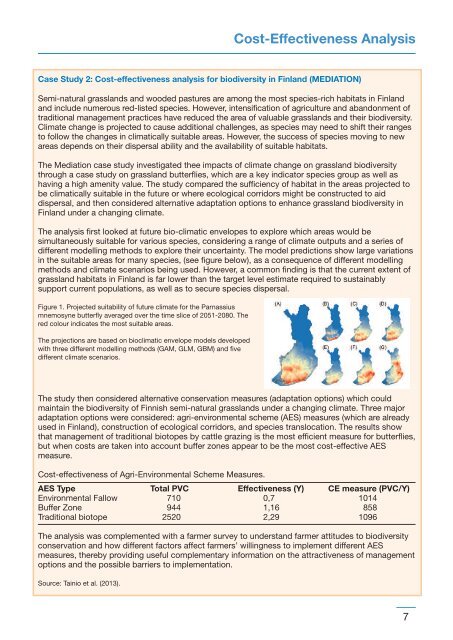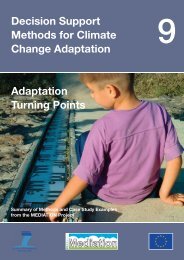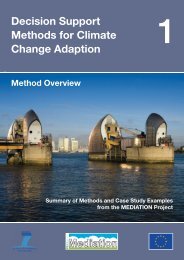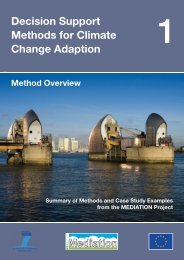Cost-Effectiveness Analysis - Mediation
Cost-Effectiveness Analysis - Mediation
Cost-Effectiveness Analysis - Mediation
- No tags were found...
You also want an ePaper? Increase the reach of your titles
YUMPU automatically turns print PDFs into web optimized ePapers that Google loves.
<strong>Cost</strong>-<strong>Effectiveness</strong> <strong>Analysis</strong>Case Study 2: <strong>Cost</strong>-effectiveness analysis for biodiversity in Finland (MEDIATION)Semi-natural grasslands and wooded pastures are among the most species-rich habitats in Finlandand include numerous red-listed species. However, intensification of agriculture and abandonment oftraditional management practices have reduced the area of valuable grasslands and their biodiversity.Climate change is projected to cause additional challenges, as species may need to shift their rangesto follow the changes in climatically suitable areas. However, the success of species moving to newareas depends on their dispersal ability and the availability of suitable habitats.The <strong>Mediation</strong> case study investigated thee impacts of climate change on grassland biodiversitythrough a case study on grassland butterflies, which are a key indicator species group as well ashaving a high amenity value. The study compared the sufficiency of habitat in the areas projected tobe climatically suitable in the future or where ecological corridors might be constructed to aiddispersal, and then considered alternative adaptation options to enhance grassland biodiversity inFinland under a changing climate.The analysis first looked at future bio-climatic envelopes to explore which areas would besimultaneously suitable for various species, considering a range of climate outputs and a series ofdifferent modelling methods to explore their uncertainty. The model predictions show large variationsin the suitable areas for many species, (see figure below), as a consequence of different modellingmethods and climate scenarios being used. However, a common finding is that the current extent ofgrassland habitats in Finland is far lower than the target level estimate required to sustainablysupport current populations, as well as to secure species dispersal.Figure 1. Projected suitability of future climate for the Parnassiusmnemosyne butterfly averaged over the time slice of 2051-2080. Thered colour indicates the most suitable areas.The projections are based on bioclimatic envelope models developedwith three different modelling methods (GAM, GLM, GBM) and fivedifferent climate scenarios.The study then considered alternative conservation measures (adaptation options) which couldmaintain the biodiversity of Finnish semi-natural grasslands under a changing climate. Three majoradaptation options were considered: agri-environmental scheme (AES) measures (which are alreadyused in Finland), construction of ecological corridors, and species translocation. The results showthat management of traditional biotopes by cattle grazing is the most efficient measure for butterflies,but when costs are taken into account buffer zones appear to be the most cost-effective AESmeasure.<strong>Cost</strong>-effectiveness of Agri-Environmental Scheme Measures.AES Type Total PVC <strong>Effectiveness</strong> (Y) CE measure (PVC/Y)Environmental Fallow 710 0,7 1014Buffer Zone 944 1,16 858Traditional biotope 2520 2,29 1096The analysis was complemented with a farmer survey to understand farmer attitudes to biodiversityconservation and how different factors affect farmers’ willingness to implement different AESmeasures, thereby providing useful complementary information on the attractiveness of managementoptions and the possible barriers to implementation.Source: Tainio et al. (2013).7





